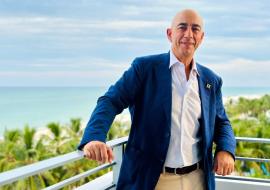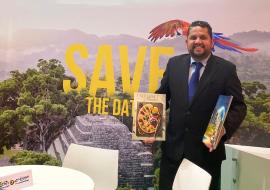Miguel Alejandro Figueras. Advisor to the Cuban Tourism Minister


Q: How do you organize scuba diving in Cuba?
A: Recreational and contemplative scuba diving has been growing all over the world. Some estimates have it there are some 9 million certified divers, a figure that adds another million with each passing year. In Cuba, this tourism-oriented activity got its big break in Varadero back in the 1970s, yet the big boost came in the early 80s on the Isle of Youth, in the area next to the Colony Hotel where the International Diving Center stands today.
This sport’s development in the past twelve years has made diving centers pop up all across the country. As we speak, we count on 37 such centers scattered all over the island.
We’ve assessed our future development policy. We’ve set out to diversify the markets, as well as a number of destinations and offers that can be considered tourist products.
According to research studies conducted with documents and information provided by the World Tourism Organization (WTO), Cuba ranks 27th among the top diving destinations. In the Caribbean realm, we’re among the top-five nations.
Since last year’s second half, we’ve been determined to carry out a more intense promotional effort, especially by having our authorities and experts attend scuba diving fairs and tradeshows all around the globe, mostly in Canada and Europe. This has let us expand our contacts with tour operators and with scuba diving training schools all over the world.
The Varadero 2003 Diving Expo marks the end of a stage and the onset of a new one. This is our first-ever diving event, either national or international. Prior to that, back in the 1980s, there were several promotional events on the island, especially devoted to underwater photography and fishing.
Q: What kind of gears and equipment is Cuba equipped with for scuba diving?
A: We’ve started with Cuba’s potentials for the development of this activity. Its sea bottoms are gorgeous and unexplored. On the other hand, we work with a highly trained personnel because the safety of divers is what really counts here. As far as equipment is concerned, we’re using the most advanced gears money can buy right now.
In the last fifteen years, scuba diving has ceased to be a risky sport, given the knowledge that we now have about the human body and the kind of equipment that we use. For instance, we can now get in touch with divers under the sea. In the course of the past four years, we’ve clicked 100,000 immersions. This means some 25,000 divers have practiced scuba diving in Cuba. We expect to increase that figure fourfold through an array of marketing and promotional strategies we’re working on right now.
Q: Tell us a tad about the main features of the Diving Expo.
A: This event we’ve just wrapped up today gathered a hundred participants from a dozen countries who exchanged views during a couple of working sessions. We managed to cluster all 37 directors of the country’s international diving centers plus 32 experienced divers who’ve taken part in similar fairs and tradeshows elsewhere. The attendance also included insurance companies and seven organizations properly certified by the National Nautical Commission. Each and every one of these institutions dictated lectures and went about their own working strategies. Participants also toured some diving centers outside Varadero. We also had the press in tow, chiefly international media organizations and specialized magazines from Germany, France, Spain and the United Kingdom.
Q: Any future plans in store?
A: The 2003 Diving Expo in Varadero has been the first try, but the Board of Directors of the Tourism Minister has agreed to hold this event on a regular basis. There’s no doubt this has been a first edition to gather experience and pave the way for next year’s expo. And we’re confident that’ll be a much better and more swarming event that will definitely put Cuba on the map as far as scuba diving is concerned.














